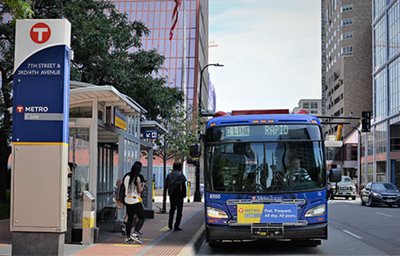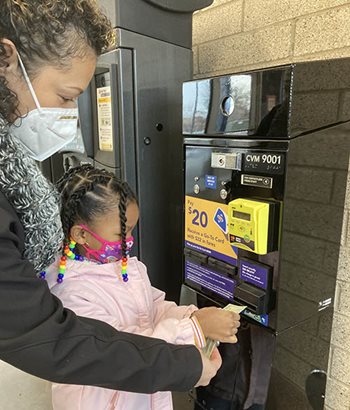 The region, like the nation and world, is facing unprecedented and unforeseen times, fundamentally changing the face of our transportation system. Shuttered businesses, canceled gatherings, reduced business capacity, working from home, and social distancing have ultimately meant reduced travel across the region.
The region, like the nation and world, is facing unprecedented and unforeseen times, fundamentally changing the face of our transportation system. Shuttered businesses, canceled gatherings, reduced business capacity, working from home, and social distancing have ultimately meant reduced travel across the region.
COVID-19 has significantly impacted transit ridership and service delivery. Ridership has fallen on all transit services — by as much as 60% on local bus routes, 70% on light rail, and 95% on express bus routes and Northstar commuter rail.
“While transit ridership has seen a big drop, the number of people who are still riding is significant,” said Metropolitan Council Chair Charlie Zelle. “Even during the pandemic, many people rely on transit to get to destinations that are essential to their lives and the region’s economy.”
“We know that when the pandemic subsides, many workers and employers may choose to continue their work from home schedules. Transit will need to continue adapting to a different service pattern because the fundamental needs of riders will have changed.”

Ridership reflects emphasis on essential trips
In 2020, overall ridership on services provided by the Met Council dropped from roughly 7 million rides a month down to about 2 million. The regional transit system, including all regional providers, went from more than 91 million rides in 2019 to about 41 million in 2020.
Despite the declines in travel due to the pandemic, some core bus routes maintained a higher portion of ridership. The METRO C Line and A Line were among the strongest routes, with the bus rapid transit trips down only 40% on average. Core local routes like the 5, 18, and 21 continue to be the workhorses of the transit system. Ninety percent of system ridership is happening on local routes and light rail, which matches the ridership split in previous years.
Council ridership showed promise in the first quarter as the number of rides paced above 2019. Then COVID-19 entered, stay-at-home orders went into place, and people followed public health guidance. Express ridership and commuter rail took the greatest hit as people who could started working from home instead of heading into the downtowns on their daily commute. Service was discontinued on many express routes because the demand simply wasn’t there.
See more detail about ridership numbers from a Feb. 22 Transportation Committee presentation (PDF).
Metro Mobility and Transit Link pivot to broaden essential services
When COVID-19 first surfaced and the stay-at-home orders went into place, traditional rides on Metro Mobility and Transit Link immediately dropped as customers complied with the order.
“We took that capacity and looked for ways that we could help that weren’t in our traditional service delivery,” said Director of Transportation Services Nick Thompson. “We replaced our normal demand with grocery and food shelf delivery, and essential health care worker trips. About half of our ridership in the last months of 2020 were these kinds of trips.”
Metro Mobility regular ridership has now returned to about half of what it was before COVID-19. With demand for Metro Mobility growing, the Met Council has begun a return to Metro Mobility’s core business to ensure there is capacity for certified riders who have a disability.

Core pandemic ridership supports future bus rapid transit investments
The way people are using the system today, while in fewer numbers, can point to opportunities as the system builds back its service in the coming years.
Metro Transit bus rapid transit and core local services have held up well during COVID-19, relative to the rest of the system. The METRO C Line bus rapid transit, which opened in June 2019, has had some of the most robust ridership that Metro Transit has seen during the pandemic.
That’s why the Met Council and Metro Transit are investing in corridors that people continue to use at higher rates, even during COVID-19. The METRO D Line, which starts construction this spring, will substantially replace Route 5, the Twin Cities' busiest local route. The METRO B Line, slated to start construction in 2023, will largely replace the second busiest Route 21, which travels between Uptown in Minneapolis to Union Depot in Saint Paul.
“The approaching expansion of our bus rapid transit network is a true turning point for our region and our riders, who will enjoy faster and more frequent service on some of our busiest transit corridors,” said Metro Transit General Manager Wes Kooistra.
“We are also hopeful that advances in the fight against the COVID-19 pandemic will allow more people to safely return to transit, and that we all have more opportunities to safely come together as a community.”
Emphasis on all-day, all-purpose trips
Ridership patterns on Metro Transit have also shifted reflecting different trip purposes and timing. Based on hour of boarding, the weekday service now looks more like a pre-pandemic Saturday. These statistics show a steady buildup of trips throughout the day, with a peak in the mid to late afternoon, and a decline into the evening. This pattern suggests that there are more all-purpose trips, covering different kinds of destinations other than a typical a.m. and p.m. peak commute to and from downtown job centers.
However, that does not mean that work trips are no longer happening. Essential workers are using transit to get to their job at other times, like a 2 p.m. commute to a grocery store shift or a 6 a.m. ride for a hospital worker. In essence, people are still using the transit system to get to critical jobs and gather the necessities that are sustaining the region’s residents during this time.
Metro Transit has also been working hard to match service to demand so that customers and operators can travel safely with social distancing, which has meant returning the frequency of some of the busiest routes to pre-pandemic levels, to allow for more capacity.

What the future holds for transit
In the near term, transit operators are keeping safety measures in place that limit capacity on transit vehicles and require customers to wear masks. The pace of vaccinations may be the key pivot point to ridership returning.
Vaccinations began with health care personnel and long-term care residents, and the state has now moved on to community vaccinations for adults 65 years of age or older and educators (prekindergarten through grade 12), school staff, and childcare workers. With these developments and additional vaccine approvals on the horizon, this clears a path for increased community movement and transit use into the summer and fall of 2021.
The pandemic has also shown that many businesses, and the people who work for them, can sustain working at a distance. This shift to teleworking has reduced the work commute during peak congestion hours. The pattern may only be short-term, or may have lasting impacts on travel choices. While commuting may change, a robust transit system remains critical for many people as a transportation option.
Ridership has begun and will continue to return. Core routes will provide trips to school when the state reopens colleges, universities, and high schools. Special events like outdoor sports and concerts will attract riders who want to avoid driving and parking in the downtowns. Businesses have also signaled that they will reopen offices and, at least in part, workers will commute again on transit to their jobs.
Transit in the region will certainly look different in the future, but it continues to be vital to a thriving region. Transit contributes to a livable and appealing region where people want to live, play, shop, and work. A strong transit system is one that works for everyone, getting people to jobs, schools and everyday needs, and opens doors to opportunity.
Tracking transit use over time
Each year the Met Council compiles data about transit ridership across the seven-county region, from Metro Transit’s bus and rail service to suburban providers’ local and express bus service, to more specialized services. Regional transit ridership combines the number of rides on all types of transit and by all the region’s transit providers.